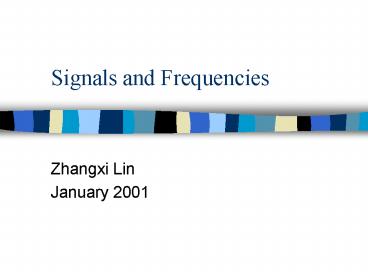Signals and Frequencies - PowerPoint PPT Presentation
1 / 13
Title:
Signals and Frequencies
Description:
frequency (f) period (T = 1/ f) phase ( ) wave ... Audio signals. 20 Hz-20 kHz ... Frequency is 525 X 30 = 15,750 lines/sec. A bandwidth of 4 MHz is needed. ... – PowerPoint PPT presentation
Number of Views:19
Avg rating:3.0/5.0
Title: Signals and Frequencies
1
Signals and Frequencies
- Zhangxi Lin
- January 2001
2
Frequencies
- DC - Direct Current
- AC - Alternating Current
- 60 Hz (cycles)
- sine wave (analog)
- Sound (20 hz through 20,000 hz)
- 1,000 hz 1 khz
3
Signals Time-Domain Concepts
- Signal travels with a velocity v (18,600
miles/sec or 300,000 km/sec). - Periodic signal
- peak amplitude (A)
- frequency (f)
- period (T 1/ f)
- phase (?)
- wave length (? vT)
4
Signals Frequency-Domain Concepts
- S(t) sin(2?ft) 1/3 sin (2 ?(3f)t)
- Fundamental frequency f
- Second frequency 3f
- Spectrum (f-3f)
- Bandwidth (3f - f 2f)
5
Analog Signals
- Audio signals
- 20 Hz-20 kHz
- Telephone channel bandwidth 4000 Hz with 300-3400
Hz for voice bandwidth. - Video signals
- TV receiver 483 lines and 30 scans per second.
In the US 525 lines are used with 42 are lost
during vertical retrace. - Frequency is 525 X 30 15,750 lines/sec
- A bandwidth of 4 MHz is needed. The standard
bandwidth is 6 MHz including guardband.
6
Transmission Impairments
- Guided media, such as twisted pair cable, coaxial
cable, and optical fiber - Attenuation signals get weaker
- Delay distortion (different velocities of
frequencies) - Noise
- Wireless transmission
- Free-space loss (distance effect)
- Atmospheric absorption (
- Multipath (signals from direct and reflected
path) - Refraction (waves are bent and change the
distance) - Thermal noise
7
Electro-magnetic Spectrum
- 30-300 Hz 10-1Mm .....ELF (extremely low
frequency) - 300-3000 Hz ....................1Mm-100 km
- 3-30 kHz 100-10 km ...........VLF
- 30-300 kHz 10-1 km .............LF
- 300-3000 kHz 1 km-100 m ....MF
8
Electro-magnetic spectrum
- 3-30 MHz 100-10 m ...................HF
- 30-300 MHz 10-1 m .................VHF
- 300-3000 MHz 1 m-10 cm .......UHF
- 3-30 GHz 10-1 cm ...................SHF (super
high frequency) - 30-300 GHz 1 cm-1 mm .......... EHF (extremely
high frequency)
9
Radar bands
- 1-2 GHz ............30-15 cm ....L Band
- 2-4 GHz ...........15-7.5 cm.....S Band
- 4-8 GHz ........7.5-3.75 cm.....C Band
- 8-12 GHz ......3.75-2.50 cm... X Band
- 12-18 GHz ......2.5-1.67 cm...Ku Band
- 8-27 GHz .....1.67-1.11 cm....K Band
10
Radar Bands - cont.
- 27-40 GHz 1.11 cm-7.5 mm .Ka Band
- 40-75 GHz...............................V Band
- 75-110 GHz............................W Band
- 110-300 GHz ......................mm Band
- 300-3000 GHz...................u mm Band
.
11
Satellite TV bands
- S-Band 1700-3000 MHz
- C-Band 3700-4200 MHz
- Ku1-Band 10.9-11.75 GHz
- Ku2-Band 11.75-12.5 GHz (DBS)
- Ku3-Band 12.5-12.75 GHz
- Ka-Band 18.0-20.0 GHz
12
Bandwidth for TV signals
13
US Frequency Allocation Chart
http//www.fair-rite.com/pr09.htm































